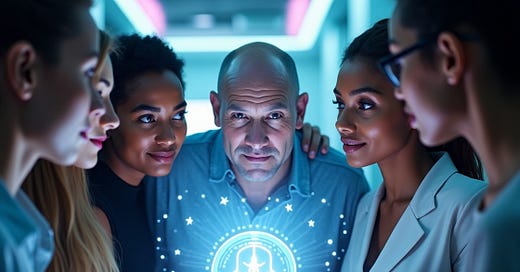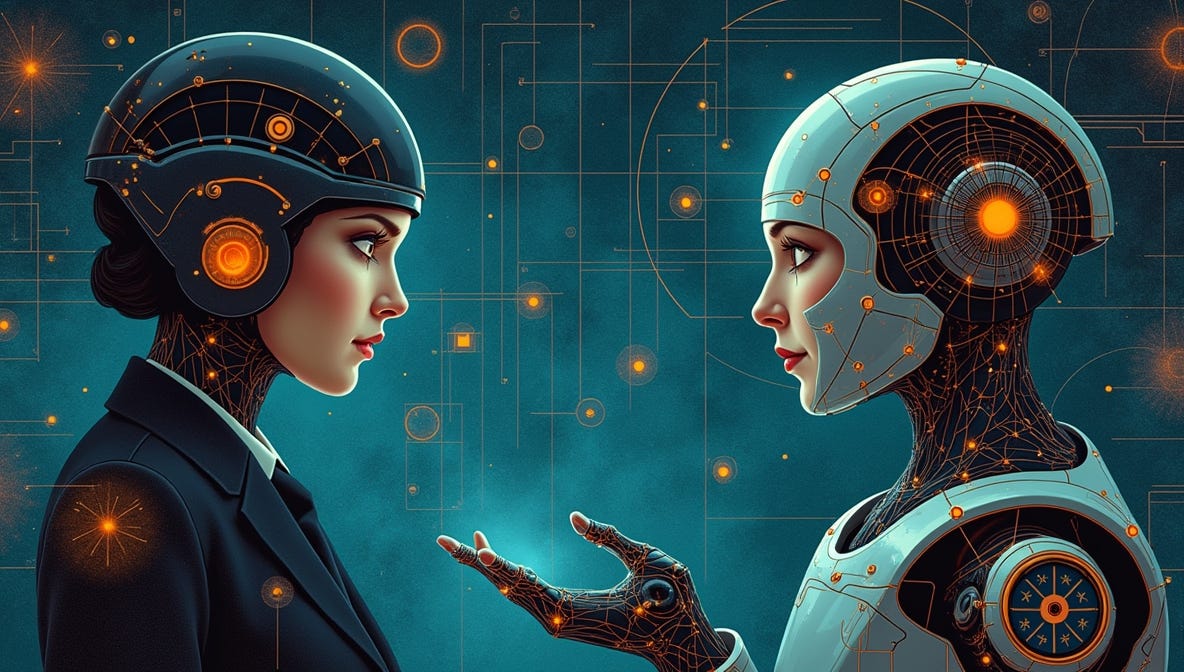Artificial intelligence (AI) is no longer the stuff of science fiction. From finance to engineering to defense, it's transforming how we work—today, not tomorrow. But as AI steps into roles once thought to be uniquely human, one question keeps surfacing: Will it take up our jobs, or will it make them better?
Recent data paints a more nuanced picture. McKinsey’s latest analysis suggests AI could add up to $4.4 trillion annually to the global economy. In the U.S., 30% of workers may see half their tasks automated by 2030, while a staggering 85% could see at least 10% of their work changed. For knowledge workers in finance, law, or engineering, these numbers are seismic.
Yet AI can’t do it alone. Human–AI collaboration is emerging as a powerful catalyst, where algorithms churn through data and humans provide insight and judgment. Together, they’re forming a new productivity engine—one that’s rewriting the future of work. This article explores how that synergy is playing out in real workplaces, what’s at stake, and why you can’t afford to sit on the sidelines.
How AI Enhances Human Productivity
AI’s greatest strength? Speed and scale. From parsing massive data sets to drafting initial content, AI slashes the grunt work so professionals can focus on what matters.
A recent Stanford study found that generative AI boosted productivity by an average of 66% for business users. Financial analysts use AI to sift through reams of market data in seconds—what once took days now takes minutes. In the legal field, AI tools review contracts at lightning speed, flagging anomalies for lawyers to investigate.
“AI doesn’t replace human judgment,” says James Manyika, Google’s SVP of Technology and Society. “It amplifies it—by doing what humans can’t do alone.”
Consider the numbers. A 2024 report by the U.S. Federal Reserve showed that AI tools save an average of 2.2 hours a week per worker, roughly 5.4% of a standard 40-hour work week. That might not sound huge, but across thousands of workers, the math adds up to serious bottom-line gains.
AI’s role isn’t just about cutting costs, either. In creative roles, it unlocks entirely new possibilities. Designers use generative AI to rapidly generate concepts, iterating faster. In software engineering, AI code-assistants have become as common as the IDE itself—helping novice coders level up, and experts move even faster.
In this new world of AI-augmented work, the real power is blending machine efficiency with human creativity. That’s where the magic happens—and it’s why so many companies are re-engineering workflows to embrace AI, not just bolt it on.
Is AI a Threat to Human Workers?
Of course, not everyone sees AI as a friendly coworker. Many fear it’s the next automation wave—poised to eat white-collar jobs the way robots devoured factory floors.
The fears aren’t unfounded. Brookings reports that 30% of U.S. jobs could see half their tasks automated by AI. Financial services, law, and software development are particularly exposed. Already, media companies have laid off journalists and editors, citing AI-generated content. And in a 2024 Adecco survey, 41% of executives said they expect smaller workforces because of AI over the next five years.
Yet history suggests a more complex story. As with every technological upheaval, job losses are only part of the picture. The World Economic Forum’s 2025 forecast projects 92 million jobs displaced worldwide by 2030—but 170 million new roles created. That’s a net gain of 78 million jobs.
“Every industrial revolution has destroyed some jobs,” notes Erik Brynjolfsson, director of Stanford’s Digital Economy Lab. “But it’s also created new ones that never existed before—roles built around the technology itself.”
Think about the last time you worked with a spreadsheet or cloud-based app. Those didn’t exist 50 years ago. AI is following the same trajectory, creating demand for prompt engineers, data stewards, and AI trainers—jobs no one had heard of a decade ago.
Still, the transition won’t be painless. Older workers and those in highly exposed roles will need new skills—and a plan to stay ahead of the curve. For those willing to learn and adapt, AI is less of a threat and more of an opportunity.
Can AI Do It Alone?
Let’s set the record straight: AI isn’t a fully autonomous worker. It can crunch numbers and draft copy, but it can’t navigate nuance, context, or the messy reality of human interactions.
Take generative AI. Thomson Reuters found that 50% of professionals see AI outputs as a “basic starting point,” while 28% call them a “strong starting point” requiring editing. That means human oversight isn’t optional—it’s essential.
In law, AI can flag risky contract clauses, but a lawyer must decide whether to act. In finance, AI can suggest trades, but a human still calls the final shots. Even in creative work, AI’s drafts need a human touch to become compelling.
Why? Because AI lacks judgment and lived experience. It can’t weigh political implications, grasp cultural nuances, or handle complex human motivations. And that’s before we get to the hallucinations—those pesky errors that creep into even the most sophisticated models.
Experts like Sam Altman, CEO of OpenAI, stress this point: “AI is a tool, not a replacement. We need humans in the loop—otherwise, we risk making decisions based on incomplete or misleading data.”
In short, AI’s impressive capabilities don’t make it a solo act. The best results come when humans and AI collaborate—where human oversight bridges AI’s blind spots and AI augments human insight. The future of work won’t be man or machine—it’ll be man and machine, working together.
Creating Synergies: Humans + AI
The real promise of AI isn’t just in cutting costs—it’s in the synergy created when humans and machines work in concert.
Here’s what that synergy looks like in practice:
Division of Labor: In customer service, chatbots handle FAQs while human agents tackle nuanced complaints. In finance, AI scans for fraud and humans investigate the flagged cases.
Creative Amplification: Marketers use AI to generate dozens of ad variants in seconds, then rely on human judgment to pick and tweak the winners. Designers use generative tools to spark ideas, but their expertise shapes the final product.
Skill Bridging: A Stanford study showed that generative AI lets junior workers perform at near-expert levels. In coding, AI suggestions elevate novice developers, letting them contribute faster. Experts, meanwhile, use AI to automate routine code—focusing on architecture and strategy.
Faster Decisions: In engineering and defense, AI models simulate complex systems, giving leaders rapid what-if analyses. But the final judgment? Still human.
What emerges is a workplace where humans aren’t just keeping pace with AI—they’re steering it. “The power of human–AI collaboration is that it blends the best of both,” says MIT’s Daniela Rus. “Machines bring speed and precision, but humans bring ethics, judgment, and creativity.”
That’s the sweet spot: a system where humans focus on what they do best—interpretation, empathy, strategic thinking—while AI handles the data and drudge work.
Is Collaboration a Must or Optional?
For industries that thrive on data and insight—finance, defense, engineering—AI is no longer a toy. It’s a competitive edge.
A PwC survey found that 78% of U.S. companies already use AI in some function. In finance alone, AI is now standard in fraud detection, risk management, and market analysis. In defense, AI-augmented simulations are shaping strategy. And across the board, businesses that harness AI are outpacing those that don’t.
This isn’t just hype. McKinsey’s latest research says companies that fully integrate AI see up to 20% higher productivity gains than those who treat it as an afterthought.
For workers, that means learning to work with AI isn’t optional. It’s the next evolution of professional skill—like mastering spreadsheets in the 1980s or digital marketing in the 2000s.
The upshot? If your rivals are using AI to cut decision times and boost output, you can’t afford to ignore it. Collaboration with AI is fast becoming the baseline for knowledge work.
The good news: AI is here to assist, not replace it. But the winners will be those who see it as a partner, not a threat.
Conclusion
The future of work isn’t man versus machine—it’s man with machine. In finance, in defense, in every data-driven industry, the lesson is the same: AI on its own is impressive, but humans give it purpose.
So as the landscape shifts, embrace it. Learn how to collaborate, not compete. Because those who harness AI’s power while bringing human insight to the table will define the next era of work.






